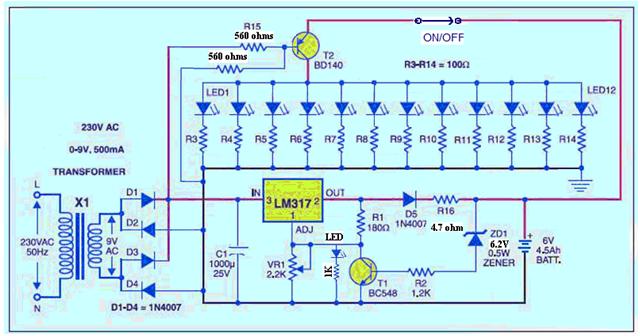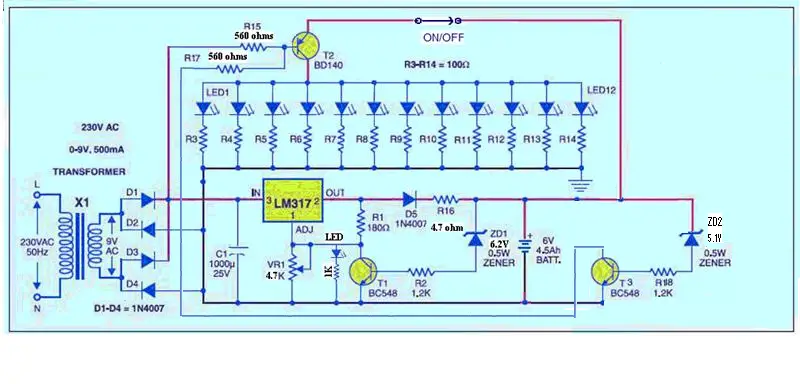Hi All Readers of CircuitsToday,
As there is serious discussions going on about our previous Automatic LED Emergency Light Circuit using LM 317, Mr.Seetharaman has come up with a modified version of the same which answers many of the doubts raised in our Comments section.
Note: Mr.Seetharaman has developed a new version of Automatic LED emergency light. This one is more simple,more efficient and uses minimum components. Take a look: Simple Emergency Lamp Circuit
Here follows Seetharaman’s Description about the Modified Automatic LED Emergency Light using LM 317.
Dear John
Since there were lots of doubts from our readers on the LED emergency light, I have written a detailed letter to two of our readers. Of course few modifications are required, which I have indicated on the drawings and on calculations how I arrived at it. I thought of enclosing it to you so that it can be kept in some library of our site for any ones reference. For each circuit we can have a similar detailed theory, may not be with all calculation, just general operation theory of each part of the circuit. You may think of it. As a first feed back I am sending this. I have a feeling that most of the people would have made the mistake in base emitter of BD140, the lead out are against normal convention.

To understand the above circuit in a better way, it can be divided into two parts.
1. LED lamp circuit
2. The Battery charger circuit
LED Lamp circuit
1. All are white hi bright LEDs rated for 3Volt @ 25mA
2. The total current requirement is 12 X 25 = 300mA
3. This current has to flow through T2 – BD140 PNP transistor
4. The minimum current gain (hfe) of this transistor @ 500mA is 50
5. Hence the base current Ib requirement is Ic / hfe, 300 / 50 = 6mA
6. Base emitter drop of T2 at 500mA is 0.77 volt
7. With the fully charged battery at 6.9volt terminal voltage (for cycle operation use) the voltage available across the new bias resistance is (6.9 – 0.77)
8. Hence the bias resistance is = 6.13 / 6 = 1000ohms
9. As the battery drains the final terminal voltage will be 5.4volt
10. The bias resistance will be (5.4 – 0.77) / 6 = 770 ohms Hence a 680 ohms was preferred for bias resistance with drained battery also it will give enough brightness.
11. The very important information about BD140 is, as you view the pins, metal portion of the transistor facing down left is emitter centre collector and right is base. Most of the constructors make this mistake, relying on the convention that left base and right emitter. If you have made this mistake please correct it.
Once this portion is checked for reliable operation we will proceed to charger portion.
PCB’s for this project can be orders through PCBWay. We shall upload gerber files (made according to rules of PCBWay) shortly.
The Battery charger circuit
1. The battery requires a full terminal voltage of 6.9V at this point charger should cut off.
2. That is the voltage across the chain ZD1, R2 and T1 be should be 6.9 volt
3. T1 be voltage of 0.7 volt plus drop across R2 and zener voltage should be 6.9V
4. T1 be current = Ic / hfe
5. Ic is 1.25 / 180 = 7mA
6. Ibe = Ic / hfe of T1 i.e = 7 / 70 = 100uA
7. Drop across R2 =1.2 X .1 mA = 0.12volt
8. Hence Zener voltage = 6.9 – (0.7 + 0.12) = 6.08 the near by preferred zener voltage is 6.2 volt
9. Say the battery voltage at full charge will be 7 volt with 6.2 volt zener diode
10. To calculate R16 value for charging at 1 /10 th of the rated current of the battery 4.5AH / 10 = 450mAH
11. Transformer 9volt AC the voltage across C1 will be 9 X 1.414 = 12.6 volt
12. The drop across LM317 at 450mA current for good regulation is 3volt
13. The drop across protective diode D5 is 0.7 volt.
14. The voltage available at cathode of D5 is 12.6 – (3+0.7) = 8.9volt
15. The battery after fair discharge will be at 6 volt
16. Hence R16 = (8.9 – 7) / 0.45 = 6 ohms
17. The nearby standard value for operation is 5 ohms.
18. At the end point of battery 5.4 volt the maximum charging current can be of (8.9 – 5.4) / 5 = 0.7 amps well within the higher charging limit of the battery.
19. With this circuit over night the battery will get charged fully.
20. Over charging is taken care and protected by T1
Hope with the above guide line you can make your light work successfully.
More Modification!!!
Automatic LED Emergency Light with Under Voltage Cut Off Protection:
Dear Readers,
Mr. Seetharaman has further modified this LED Emergency Light with an under voltage cut-off protection to protect battery from deep discharge. Once the battery terminal voltage falls below 5.7 volts the LEDs will be switched off. Take a look at the modified circuit shown below.

To understand the above circuit in a better way, it can be divided into two parts.
-
- LED lamp circuit
- The Battery charger circuit
LED Lamp circuit
-
- All are white hi bright LEDs rated for 3Volt @ 25mA
- The total current requirement is 12 X 25 = 300mA
- This current has to flow through T2 – BD140 PNP transistor
- The minimum current gain (hfe) of this transistor @ 500mA is 50
- Hence the base current Ib requirement is Ic / hfe, 300 / 50 = 6mA
- Base emitter drop of T2 at 500mA is 0.77 volt
- With the fully charged battery at 6.9volt terminal voltage (for cycle operation use) the voltage available across the new bias resistance is (6.9 – 0.77)
- Hence the bias resistance is = 6.13 / 6 = 1000ohms
- As the battery drains the final terminal voltage will be 5.4volt
- The bias resistance will be (5.4 – 0.77) / 6 = 770 ohms Hence a 680 ohms was preferred for bias resistance with drained battery also it will give enough brightness.
- The very important information about BD140 is, as you view the pins, metal portion of the transistor facing down left is emitter centre collector and right is base. Most of the constructors make this mistake, relying on the convention that left base and right emitter. If you have made this mistake please correct it.
Once this portion is checked for reliable operation we will proceed to charger portion.
- The battery requires a full terminal voltage of 6.9V at this point charger should cut off.
- That is the voltage across the chain ZD1, R2 and T1 be should be 6.9 volt
- T1 be voltage of 0.7 volt plus drop across R2 and zener voltage should be 6.9V
- T1 be current = Ic / hfe
- Ic is 1.25 / 180 = 7mA
- Ibe = Ic / hfe of T1 i.e = 7 / 70 = 100uA
- Drop across R2 =1.2 X .1 mA = 0.12volt
- Hence Zener voltage = 6.9 – (0.7 + 0.12) = 6.08 the near by preferred zener voltage is 6.2 volt
- Say the battery voltage at full charge will be 7 volt with 6.2 volt zener diode
- To calculate R16 value for charging at 1 /10 th of the rated current of the battery 4.5AH / 10 = 450mAH
- Transformer 9volt AC the voltage across C1 will be 9 X 1.414 = 12.6 volt
- The drop across LM317 at 450mA current for good regulation is 3volt
- The drop across protective diode D5 is 0.7 volt.
- The voltage available at cathode of D5 is 12.6 – (3+0.7) = 8.9volt
- The battery after fair discharge will be at 6 volt
- Hence R16 = (8.9 – 7) / 0.45 = 6 ohms
- The nearby standard value for operation is 5 ohms.
- At the end point of battery 5.4 volt the maximum charging current can be of (8.9 – 5.4) / 5 = 0.7 amps well within the higher charging limit of the battery.
- With this circuit over night the battery will get charged fully.
- Over charging is taken care and protected by T1
Hope with the above guide line you can make your light work successfully.

545 Comments
I have made the circuit as per the design. But the leds are not working automatically. It doesn’t switch off during charging. It glows even if there’s power and glows until the switch is off or the battery is low. Can you please advice me about this ? I have used the first circuit in this page.
Can you have pcb diagram of this circuit??
Plz give the circuit with 4v and 12v battery
plz sir sent me parts details & transistor pinout (like ECB) indicate as because i am fully new. so difficult to realize your diagram. Please sir help me. Plz Plz sir waiting for ur reply.
Sir,
Good Morning,
good and very simple to construct your circuit.
For the above circuit, can connect 3V motor pump for aquarium (Fish tank) with series of 4 diode to drop the 3V in the battery +ve side instead of LED load. If it is wrong, Please reply with good solution.
I am awaiting for your reply ASAP
Regards
Rajeesh.K
Hi,
I see 2 potential issues:
BD140 being an PNP, how it will shut down the circuit at under voltage
how to use 12volt led light connection
can i use relay in place of bd 140 for high watt led (e.g ten 1w led)
How can this diagram be converted to use a 12v battery
Can this circuit be change to a 12v battery and please forward me the change
The LEDs will NEVER TURN OFF !!!!!!! The 560R and 560R form a voltage divider that keep the LEDs on all the time !!!!! Another circuit that has not been tested !!!!!